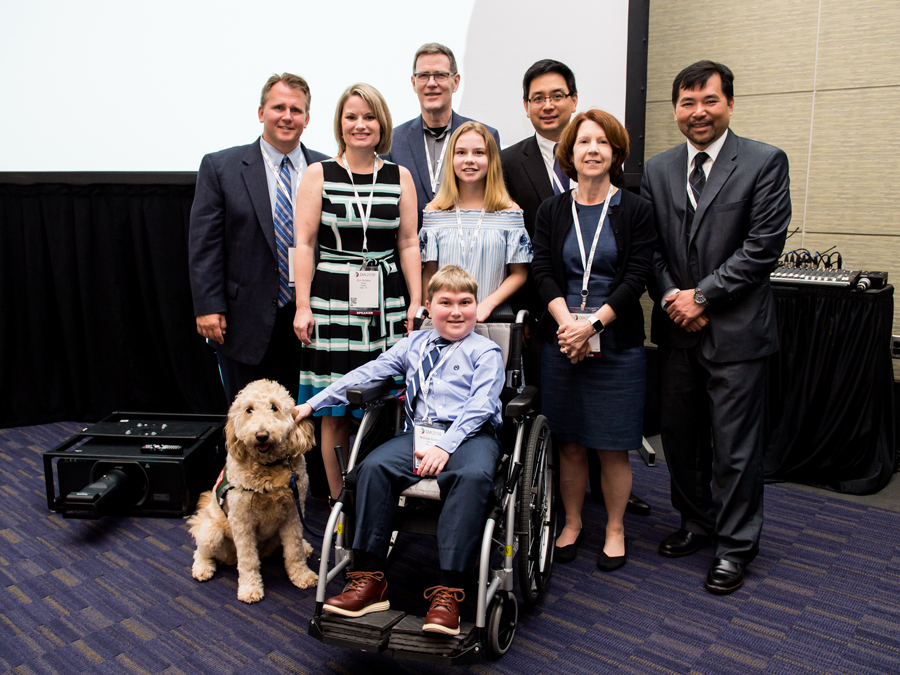Proceedings: DIA 2018 Global Annual Meeting

Central Venous Access Device in a Pediatric Trial: A Case Study of Multi-Stakeholder Engagement for Patient Benefit
Chris M. Slawecki
DIA Senior Digital Copy Editor
he process of amending a pediatric trial protocol elicits numerous ethical, clinical, and regulatory considerations. Where are the challenges in these processes? Are there opportunities for all clinical trial stakeholders, including patients and their parents, to work through these challenges together? “Regulatory and Ethical Considerations with Placebo Administration Using a Central Venous Access Device in a Pediatric Trial” provided answers through its practical process review of one such protocol amendment.
The Study
ESSENCE is a double-blind, multi-center, placebo-controlled 96-week study to evaluate the efficacy and safety of SRP-4045 and SRP-4053 in Duchenne Muscular Dystrophy (DMD) patients with deletion mutations that are amenable to skipping exons 45 or 53. It is relatively long and large for a pediatric rare disease study – “the most rigorous clinical trial in this disease space,” explained the principal investigator.
Alberto Grignolo and Robert Nelson discuss the medical and ethical aspects of pediatric clinical trials.
The Situation
ESSENCE encompassed several clinical issues:
- 96-week study duration
- Weekly IV infusion of one of two study drugs
- Weekly IV infusion of placebo
- One out of every three patients would receive weekly placebo infusions for 96 weeks.
Many DMD patients suffer from peripheral venous access difficulties, which quickly became an issue for everyone involved with this study. One patient did not get the study drug for 28 weeks due to inability to access veins; for another patient, only his father (a registered nurse) was able to insert the peripheral IV.
The Suggestion
Venous access was especially difficult for one of the oldest patients in this trial, 13-year-old Nicholas Bullers. After a particularly difficult infusion attempt on January 5, 2017, his parents were so concerned about his physical and emotional distress that they asked their clinical study coordinator if their son could receive the study drug through a central venous access device (port), or totally implantable central venous access device (TICVAD), instead of IV administration. The study coordinator contacted the principal investigator, who contacted the study sponsor, who directed the family to send their request and supporting documentation to the FDA Division of Neurology and the FDA Pediatric Ethicist. They sent their request on January 25, 2017.
The Solution
On February 22, 2017, the FDA Office of Pediatric Therapeutics responded and recommended the process of amending the protocol in accordance with the safeguards for children participating in clinical studies established by Code of Federal Regulations Title 21, Part 50, Protection of Human Subjects; Subpart D, Additional Safeguards for Children in Clinical Investigations.
The clinical team submitted this amendment under FDA Regulation 21 CFR 50.54, which states that this investigation could be allowed to proceed if
(a) The IRB finds that the clinical investigation presents a reasonable opportunity to further the understanding, prevention, or alleviation of a serious problem affecting the health or welfare of children; and
(b) The Commissioner of Food and Drugs, after consultation with a panel of experts in pertinent disciplines (for example: science, medicine, education, ethics, law) [Pediatric Committee and Pediatric Ethics Subcommittee, in this case] and following opportunity for public review and comment, determines that…
(i) The clinical investigation presents a reasonable opportunity to further the understanding, prevention, or alleviation of a serious problem affecting the health or welfare of children.
The IRB unanimously supported this amendment to the study, and an amended version of this protocol (with an option to allow use of alternative venous access methods including midline catheters, central lines, and ports at all study sites) was submitted on March 15, 2017, to FDA for review under 21 CFR 50.54.
FDA convened a joint meeting of the Pediatric Advisory Committee and Pediatric Ethics Subcommittee on May 18, 2017, where the responsible FDA pediatric ethicist, IRB chair, principal investigator, and patient Nicholas Bullers and his family delivered presentations supporting the requested amendment.
On the same day, the expert FDA panel unanimously voted yes on the question: Are there circumstances under which the use of an indwelling central venous access device in the ESSENCE clinical trial ought to be allowed?
On May 25, 2017, the Deputy Commissioner’s Determination that the study could proceed under 21CFR 50.54 was issued. The total time from initial IRB contact to FDA letter to proceed was approximately ten weeks. “The two-month turnaround felt like a lifetime for us,” said patient Nicholas Bullers’ mother Erin.
Session Chair: Robert Nelson, Johnson & Johnson
Panelists: Brett and Erin Bullers (parents); Nicholas Bullers (patient); Jonathan Lu, Sarepta Therapeutics (sponsor); Perry Shieh, UCLA Medical Center (principal investigator); Donna Snyder, FDA (Pediatric Ethics Team Lead)
Subsequent Steps
After the amended protocol was approved, 34 percent of ESSENCE patients had central venous ports placed. There have been no Significant Adverse Events related to port placement or use. In the thirteen months since this meeting, no patients have had a gap in dosing or had to drop out of the trial due to IV access issues.
Drs. Nelson and Snyder are co-authors of a pending book chapter on this subject, Invasive Placebos, Patient Burdens and Community Advocacy: A Federal Ethics Panel Protocol Review, to be published in the second edition of Ethics and Research with Children: A Case-Based Approach.
In Summary
Ports/TICVADs were originally not allowed in the ESSENCE study based on benefit-risk analysis for patients who would be randomized to placebo instead of to study drug. However, the original protocol did not fully consider the risks of physical and psychological discomfort in patients with difficult IV access. After re-evaluating these risks and benefits in the context of ESSENCE, the study of a promising investigational medication in a severe pediatric disease with unmet medical need, FDA determined that TICVADs were acceptable in this study.

Nicholas Bullers shares his thoughts about his presentation to the FDA Pediatric Advisory Committee and Pediatric Ethics Subcommittee.

Back row: Brett Bullers, Robert Nelson, Perry Shieh, Jonathan Lu; center row: Erin Bullers, Brooke Bullers, Donna Snyder; front row: S’more, Nicholas Bullers.

